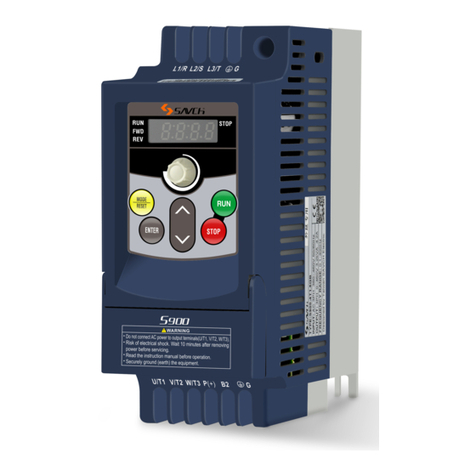
1
Thank you for choosing SANCH inverter! This instruction manual, which includes operation descrip-
tions and notes for maintenance, shall be delivered to the end-user.
For safety running and effective operation, this instruction manual shall be read thoroughly prior to
use, which shall also be preserved for later use. Provided problems occur and solution is not
provided in this instruction manual, contact your SANCH ELECTRIC representative or contact with
our company directly. Our professional technicians will serve for you actively. And please continue to
adopt products of SANCH, give valuable opinion and advice.
1. READING INSTRUCTIONS
Symbols of” DANGER” and” CAUTION” in the manual indicates that, for safety running or mainte-
nance of inverters or other electrical products, attention shall be attached during delivering, installa-
tion, operation and checks for the inverter. And these notes shall be applied for a better and safer
operation.
2. PRODUCTS RECEIVING
All products have been performed with strict test and inspection. After receiving the inverters, the
following checks shall be performed.
To check that SANCH inverter, an instruction manual and a cover is inside of the package
To check whether model number correspond with model and capacity your purchase order.
To check whether there are damaged parts during transportation and delivering. If there are, do
not connect with power supply.
If any of the above checkpoints are not satisfactory, contact your SANCH ELECTRIC representa-
tive for a quick resolution.
Never connect wires while power on. Do not check components or signal for circuit board
during operation.
Do not dismantle or change inner wire, circuit or components unnecessarily.
Make sure grounding terminals are correctly grounded. 220V level: Grounding Ⅲ; 440V level:
Special Grounding
If not used correctly, personnel damage even death may be caused.
If not used correctly, serious damage to inverter or machine may be resulted.
DANGER
DANGER
CAUTION
CAUTION
●
Do not perform a withstand voltage test for components of inverter, it can cause semi-
conductor components to be damaged by high voltage.
Never connect the output terminals U, V, W to AC power supply.
IC of CMOS on control circuit of the inverter shall be damaged by electrostatic influence. Do
not touch main circuit board.
●
●
●
●
●
●
●
●
●
PREFACE




























